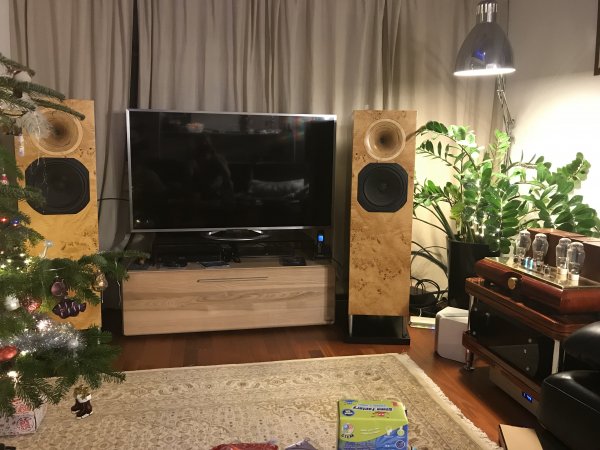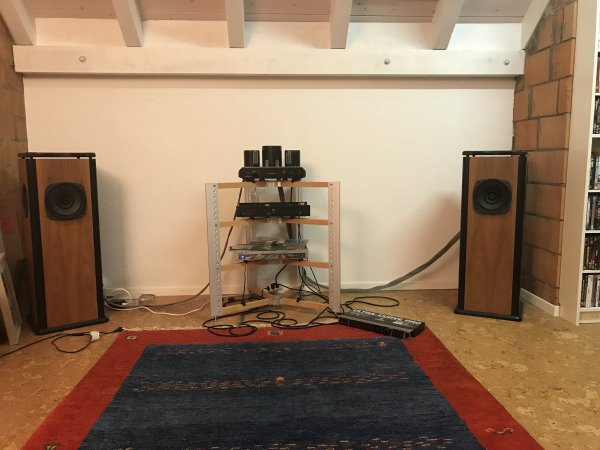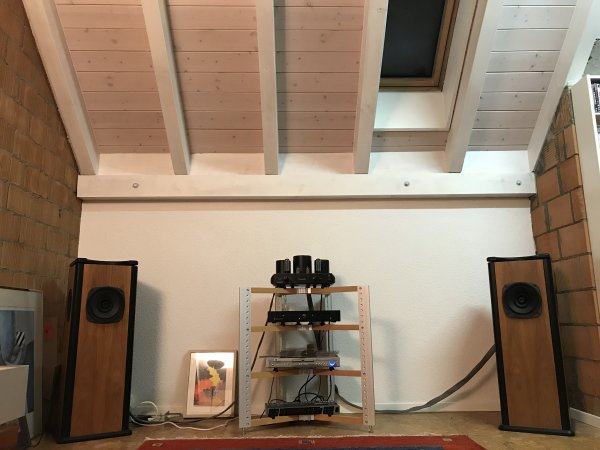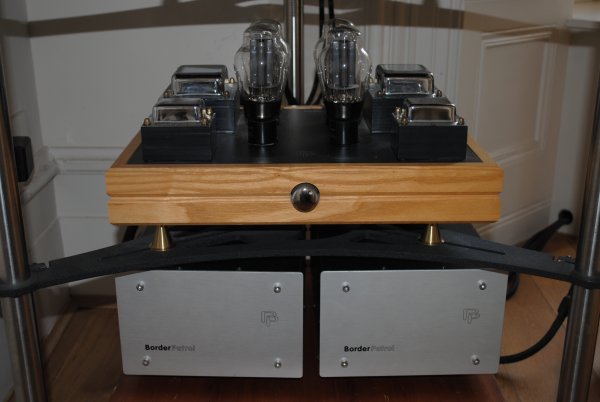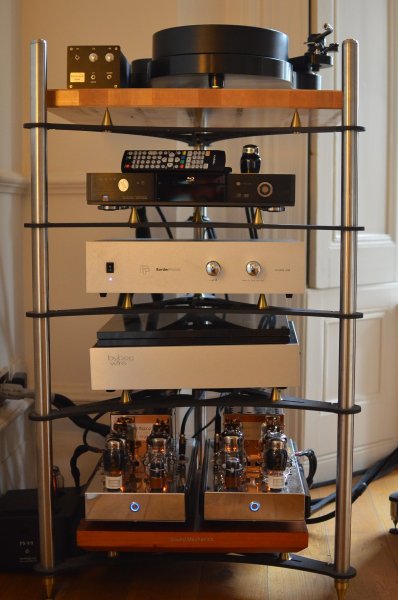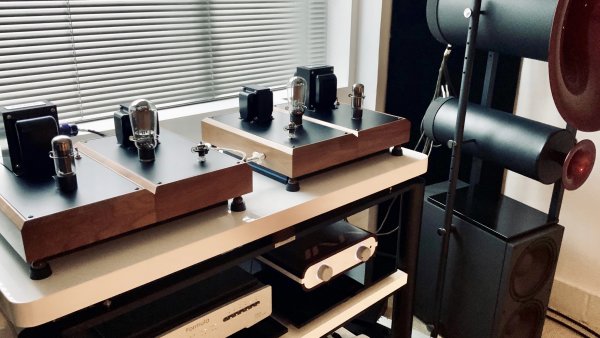I think he means more 40-70 watts PSET and not a circlotron design like the VA200What power are you looking at? KR va 200 is the best high powered such amp I have heard, and it is multiple valves. But then you have to make sure they stay in sync over time. Jack will probably tell you the same
SET amp owners thread
- Thread starter bonzo75
- Start date
You are using an out of date browser. It may not display this or other websites correctly.
You should upgrade or use an alternative browser.
You should upgrade or use an alternative browser.
I would have said the same about my crossfire III until about 10 months ago when I got the Genus.Several years ago I was looking for a great “low power” tube amp. I had heard the Ayon amps at many international shows and in every case they performed superbly. So I asked Gerhardt Hirt, owner of Ayon, this question: “If power level is not a consideration, which amp has the best purity of their amplifiers?”. He recommended the Crossfire which has a single output tube (per channel). I have had many amplifiers in house and the Crossfire is still our favorite (with all the caveats. Within power limit and amplifier to speaker synergy).
And then some amplifiers with multiple output tubes can be run with some of the tubes unplugged. Check with the manufacturer on this.
Depends on the amp biasing scheme.So my question to everyone is that if a tube goes in one channel do you replace just it or do you replace the same tube in the other channel as well or do you rely on buying from someone who will provide a perfectly matched tube to the other channel
Wow, nice job Dave!
What feets are you using, also a tweaked part?
Thanks!
The feet are Herbie's iso-ball, the firm cup with "supersonic hardball" balls, which are some sort of extremely hard rubber ball. They're as good as any footer I've used, but I haven't tried some platforms others have really liked. Footers and isolation is interesting, I've had good luck with isolating speakers using IsoAcoustics stands and using harder footers for components.
(... ) Either way, you have a dealer that has matched the stock for you or you have the equipment to do it yourself.
For small signal tubes its is not as critical and the only real parameter that matters is noise and that takes patience and some sort of circuit to listen to the tube. Matched sections here are usually obsessed over unnecessarily. I'll take a mismatched section tube any day that is quiet over a matched section tube that is noisy. YMMV and all that. The VTV analyzer does a good job on section matching and noise analysis (...)
Although the needs of selection will always depend on the circuit , most of the time the gain (or transconductance) is critical in small signal tubes. Even in circuits with some negative feedback, that apparently compensate for differences in gain, the sound signature depends on the gain of the tubes. Many times I have seen large differences in distorttion spectra between left and right channels in tube preamplifiers due to tube mismatch. Stereophile measurements sometimes also show it. But yes, noisy tubes are unusable.
Thanks, interesting!Thanks!
The feet are Herbie's iso-ball, the firm cup with "supersonic hardball" balls, which are some sort of extremely hard rubber ball. They're as good as any footer I've used, but I haven't tried some platforms others have really liked. Footers and isolation is interesting, I've had good luck with isolating speakers using IsoAcoustics stands and using harder footers for components.
From experience a tube, same type, same manufacturer, can measure similarly but sound different.I was not addressing push- pull amplifiers , but tubes in parallel - this is a SET thread!
When you replace the tube the other tube, even of the same brand , the tube is not exactly the same but still sounds the same. Saying "similarly" is this case is like explaining that an helicopter can fly comparing it with a fixed wing aircraft.
Do not assume all tubes sound alike even when they measure closely and swapping tubes left to right may bring better sound quality.
Just treat each tube as unique.
Blue58
Wow, thanks. If I may ask, are you tweaking by yourself or with the help of Ze'ev? Reason I ask is someone like me may struggle. Are you planning to experiments with the other midrange drivers as well like the Voxatix or sticking to the Horn?Both the Devore, Vittora and the Harbeth for that matter, are very well worked out products that have been optimized by their respective designers. So they are in a different class than a kit speaker with many moving parts and options. So, the PAP needs to be tweaked out with work on the crossover, wiring, baffle materials and footers. That is a lot of time and energy to invest but the good news is that the HORN1 mid/tweet is obviously exceptional. The key will be to get the bass section to integrate seamlessly with the horn. In its current state the bass section is a step behind and a bit wooly to fully match the horn. Nothing major and not unlike many speakers that mate a dynamic driver to a horn. So, we are designing a different baffle and support frame to stiffen it up. And we may make the baffle a bit wider to reduce front to back cancellation. We have already improved the crossover by using point to point wiring, bypassing the supplied PCB. This made a very substantial difference.
Thanks Bill,Love the look of your amps, Barry!
I wanted a very clean look without lots of screws. Only wish I could achieve the level of finish as on the Thomas Mayer amps.
Guys, I bought them BECAUSE I thought they do have potentialI told him the same thing back when he bought them
Since when are the La Bohèmes allowed in the living room?
From experience a tube, same type, same manufacturer, can measure similarly but sound different.
Do not assume all tubes sound alike even when they measure closely and swapping tubes left to right may bring better sound quality.
Hi! This is a good remark, but it depends on what you measure. A simple emission or transconductance test does not tell much about the overall condition of the tube but only tests one op point. A better comparison is the measurement of the entire set of plate curves. When the set of curves are identical still a sound difference might be there if the tubes have different grid current (different quality of vacuum). If the amplifier circuit is sensitive to that the tubes can still sound different, however a well designed driver in an amp can easily handle different amounts of grid current so that they do not impact sound quality. This is the reason I prefer rather strong driver tubes, preferable a second power tube.
Your remark is vary valuable for those who compare different brands of tubes and conclude a general sound character of a brand form that comparison.
Thomas
Thanks Bill,
I wanted a very clean look without lots of screws. Only wish I could achieve the level of finish as on the Thomas Mayer amps.
I dunno Barry - I think they look right up there externally. Any shots of the internals?
Wow, thanks. If I may ask, are you tweaking by yourself or with the help of Ze'ev? Reason I ask is someone like me may struggle. Are you planning to experiments with the other midrange drivers as well like the Voxatix or sticking to the Horn?
Ze’ev who is one of the owners of PAP came to visit our factory a few months back. Unfortunately, I was out of town at the time but Richard and Mino gave him a tour and then they all spent some time in the reference room listening to the Quintet. At this time we were using the Constellation kit to power them. We had already started some mod experiments so we demonstrated them to him. The first, obviously, was using our VTX, hollow tube, wiring to cable the speakers. We used 12 gauge to the woofers and a 16VTX-FEP to the Horn1. Then, we demonstrated the mod to the crossover PCB. We had modified one PCB and left the other stock. This is the Leonidas crossover BTW. We played a mono signal and switched from one speaker to the other. The difference in clarity and transparency was OBVIOUS to everyone. Ze’ev was a bit startled by the result and was certain that we had made some other change so Mino had him examine the speakers and the crossovers. Easy to do since the PAP open baffle design leaves everything exposed.
Ze’ev apparently is or has already developed different baffles for the speaker. I think he said something about using wood normally used in a piano. Of course I would love to give those a try. But we are doing something a bit different as we have our own ideas that we want to play around with. We are making a single, monolithic baffle for all the drivers from layered bamboo stock. And with it a support frame and platform made from the same material. We intend to make a hole in the support platform for the crossover and suspend it (float it) with some of the polymer isolation straps we use for the DF-SS cable support product.
Last edited:
Although the needs of selection will always depend on the circuit , most of the time the gain (or transconductance) is critical in small signal tubes. Even in circuits with some negative feedback, that apparently compensate for differences in gain, the sound signature depends on the gain of the tubes. Many times I have seen large differences in distorttion spectra between left and right channels in tube preamplifiers due to tube mismatch. Stereophile measurements sometimes also show it. But yes, noisy tubes are unusable.
Agreed, I was trying to make a general point. Section to section transconductance is ideally matched but if it is say, within 10% section to section I worry more about the noise.
Finding section to section matched tubes is very difficult with NOS as we don't have the populations to choose from. We then have to worry about the construction variants of the same tube and our obsession with that. Life goes on.
Cheers.
Similar threads
- Replies
- 16
- Views
- 2K
- Replies
- 4
- Views
- 937
- Replies
- 0
- Views
- 633
- Replies
- 15
- Views
- 1K
| Steve Williams Site Founder | Site Owner | Administrator | Ron Resnick Site Owner | Administrator | Julian (The Fixer) Website Build | Marketing Managersing |
















